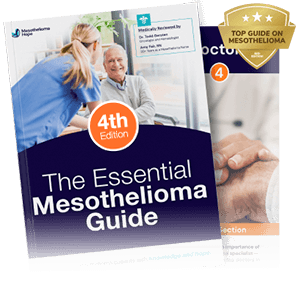What Is Mesothelioma Multimodal Therapy?
Mesothelioma multimodal therapy involves the combination of chemotherapy, and radiation therapy to kill cancer cells, stop the spread of cancer cells, and improve life expectancy for patients. Multimodal therapy is tailored to each patient’s unique case based on their eligibility for certain treatments, overall health, and how far their cancer has progressed.

The most-used multimodal therapy approaches are radiation and chemotherapy that is administered before, during, and/or after surgery.
While multimodal approaches and treatments can be highly effective, they are not always the best option depending on the stage of cancer or a patient’s health or medical history.
Consulting with a specialist about the benefits and side effects can help determine if multimodal therapy is the best option for treating your or a loved one’s mesothelioma.
To learn more about your various treatment options, order our Free Mesothelioma Guide now and have it shipped to your door overnight.
Benefits of Mesothelioma Multimodal Therapy
Several studies have found that multimodal therapy is incredibly effective in treating mesothelioma. This may be due to the aggressive behavior of mesothelioma cancer cells. Using multiple treatment methods decreases the chances that cells will break off and spread to other parts of the body, and, as a result, it may increase survival time.
A 2022 Baylor College of Medicine study found that treating malignant pleural mesothelioma (MPM) patients with immunotherapy ahead of surgery — specifically durvalumab plus tremelimumab — resulted in favorable clinical outcomes, including “a provocative signal in increased overall survival.”
Survival rates are used as only an approximation of life expectancy for patients. These estimates vary for each person depending on the treatment they receive and other factors.
Speak to your doctor about survival rate statistics and specific benefits you may see with multimodal therapy.
Mesothelioma Multimodal Therapy Approaches
There are two main approaches to multimodal therapy for mesothelioma patients: adjuvant therapy and neoadjuvant therapy.
Learn more about each approach below.
Adjuvant Therapy
Used primarily after surgery, adjuvant therapy is considered additional treatment to minimize the risk of the cancer returning. While surgery removes as much of visible cancer cells as possible, microscopic bits may remain undetected and additional treatments may stop any returning cell growth.
Treatment options for adjuvant therapy may include:
- Chemotherapy: Anti-cancer drugs that enter the entire body into the bloodstream to kill cancer orally or by vein.
- Hormone therapy: Analysis of cancerous cells sometimes reveals a sensitivity to hormones. Treatments to stop the hormone production or block the effect of the hormone may be beneficial.
- Immunotherapy: A method of working with the body’s immune system to fight off remaining cancer cells by stimulating or supplementing the body’s defenses.
- Radiation therapy: High-powered energy beams (like X-rays) that enter the body internally or externally to kill cancer cells. Adjuvant radiation therapy targets the area around the original cancer location to reduce the risk of recurrent growth.
- Targeted therapy: Used to alter specific abnormalities in certain cancer cells to target the unique features and use targeted therapy drugs to work on eliminating those cells.
Adjuvant therapy is not beneficial to all patients, and potential side effects of these treatments can be severe for some patients. Please consult with your doctor about these factors when discussing treatment options.
Neoadjuvant Therapy
Adjuvant therapy used before the main treatment of mesothelioma is called neoadjuvant therapy and is used primarily to make radiation or surgery more effective and easier. Given as a first step in treatment, usually before surgery, this works to shrink tumors as a form of initial care (induction therapy).
Treatment options for neoadjuvant therapy may include:
- Chemotherapy: Anti-cancer drugs that enter the entire body through the bloodstream to kill cancer orally or by vein.
- Hormone therapy: Analysis of cancerous cells sometimes reveals a sensitivity to hormones. Treatments to stop the hormone production or block the effect of the hormone may be beneficial.
- Radiation therapy: High-powered energy beams (like X-rays) that enter the body internally or externally to kill cancer cells. Adjuvant radiation therapy targets the area around the original cancer location to reduce the risk of recurrent growth.
Neoadjuvant therapy is not beneficial to all patients, and the potential side effects of these treatments can be severe for some patients, so please consult with your doctor about these factors when discussing treatment options.
Types of Mesothelioma Multimodal Therapy
There are different types of multimodal therapy combinations proven to effectively treat different types of mesothelioma. Many multimodal therapies started out as unconventional approaches but are now recognized for their innovativeness in targeting and treating mesothelioma.
The types of multimodal therapy listed below are not an exhaustive list. In fact, mesothelioma specialists may even combine the treatments listed below with other treatment options as well. The best way to determine a multimodal treatment plan for you is to work with a mesothelioma specialist.
Use our Free Doctor Match to find a specialist near you who’s experienced in multimodal therapy.
Cytoreduction With Hyperthermic Intraperitoneal Chemotherapy (HIPEC)
One of the most commonly used procedures for peritoneal mesothelioma is a multimodal approach that combines surgery and chemotherapy.
Cytoreduction with HIPEC involves begins with surgery to remove any visible tumors in the peritoneum, or lining of the abdominal cavity. Then the surgical site is treated with heated chemotherapy drugs to kill any remaining mesothelioma cancer cells.
This treatment is effective because it removes the bulk of cancerous tumors and treats any cells that may have broken off during surgery with targeted chemotherapy.
Immunotherapy With Surgery or Chemotherapy
Recently approved by the U.S. Food and Drug Administration (FDA), immunotherapy is now considered a mainstream treatment option for mesothelioma. It uses immune-boosting drugs to strengthen the immune system’s ability to target and kill mesothelioma cancer cells.
A study published in 2022 found that when immunotherapy was combined with surgery or chemotherapy, patients had longer median life expectancies. Researchers believe immunotherapy not only helps the body attack cancer cells but also recover from more invasive treatments like surgery.
SMART
Surgery for mesothelioma after radiation therapy, also known as SMART, uses a multimodal approach for pleural mesothelioma patients.
SMART is a two-step process that involves:
- Intensity-modulated radiation therapy (IMRT): Patients are given a high dose of IMRT, which administers simultaneous levels of radiation through the area. Radiation levels are higher than normal treatments and are made possible only because the irradiated lung is removed shortly after treatment.
- Extrapleural pneumonectomy (EPP): Approximately 6 days after a patient is given IMRT, the affected lung and surrounding tissue is removed. Further studies are being conducted to try to save the lung for patients in the future.
The success of SMART is largely due to confining cancer to the lung and the tumor, while the other mesothelioma cells are killed throughout the chest cavity. This treatment has increased results because the chances of the radiation or cancerous cells moving through the body are deliberately limited.
Getting Mesothelioma Multimodal Therapy
Mesothelioma clinical trials are currently testing new treatments and procedures for patients who are unable to undergo traditional treatment. If the cancer is too advanced, targeted therapies administered through a clinical trial in combination with other treatments may be the best method to achieve long-term survival and improve quality of life.
You should speak with a mesothelioma doctor about multimodal therapies in combination with new treatments available in clinical trials to learn if this option is the best approach for you.
To find a mesothelioma specialist near you who can help you get multimodal therapy, contact our Patient Advocates today at (866) 608-8933.
Mesothelioma Multimodal Therapy FAQs
What is multimodal therapy?
Multimodal therapy combines two or more mesothelioma treatment options into one treatment plan. It has been shown to improve a patient’s life expectancy. It is tailored to each patient’s unique case based on their eligibility for certain treatments, overall health, and how far the cancer has progressed.
Working with a mesothelioma specialist is the best way to determine if you might be eligible for multimodal treatment plans.
Are there side effects to multimodal therapy?
Since multimodal treatments combine multiple treatment methods, some patients may experience a wide range of side effects related to each specific treatment method. For example, patients who undergo surgery and chemotherapy in their multimodal therapy may experience fatigue from both the chemotherapy drugs and the body’s natural recovery from surgery.
If you are experiencing side effects, talk with your doctor — they might be able to recommend ways to help manage these symptoms.





